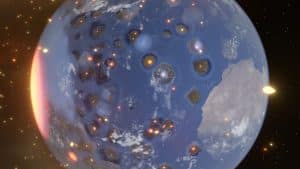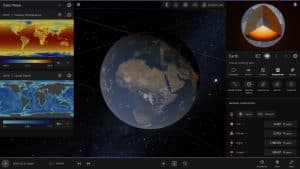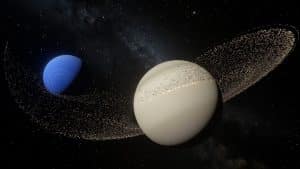Universe Sandbox
Related Games
Description
🔥 What is Universe Sandbox for PC
Universe Sandbox is a physics-based space simulation developed and published by Giant Army, allowing players to create, destroy, and explore the cosmos in real time. This sandbox experience blends astrophysics and creative experimentation, letting you simulate gravity, collisions, climate, planetary orbits, and even galactic-scale interactions with stunning accuracy. Rather than just a game, it’s an interactive playground for those fascinated by the beauty and chaos of the universe.
The simulation covers everything from star formation and orbital dynamics to the potential destruction of entire solar systems. Players can manipulate time, scale, and matter with an intuitive interface, turning scientific data into tangible visual experiences. Want to see what happens if you collide Earth with Jupiter or replace the Sun with a black hole? Universe Sandbox makes it possible and visually breathtaking.
At its core, Universe Sandbox combines scientific realism with the unrestrained imagination of a child looking up at the stars. It’s an experience where you can experiment with the laws of nature, watch entire systems evolve, and gain a deeper understanding of cosmic phenomena all while indulging in pure creative chaos.
👉 Features of Universe Sandbox
Realistic Physics Simulation
The foundation of Universe Sandbox lies in its meticulously detailed physics engine, simulating gravity, thermodynamics, and orbital mechanics with scientific precision. Every object in the game whether a moon or a supermassive black hole interacts dynamically according to mass, distance, and velocity.
This results in a breathtakingly authentic cosmic ballet where galaxies merge, planets crumble, and stars are born. The inclusion of real astronomical data ensures that every experiment feels grounded, giving players both an educational and awe-inspiring experience.
Interactive Creation Tools
Players can sculpt entire universes using intuitive drag and drop tools. You can spawn stars, planets, moons, and asteroids, then instantly adjust their properties such as mass, density, or temperature. The game allows complete freedom to design stable or chaotic systems depending on your curiosity.
Even small changes like increasing a planet’s rotation speed or altering its tilt can lead to spectacular results. Watching an artificially constructed solar system stabilize or collapse becomes an addictive and educational experience that rewards experimentation.
Dynamic Climate and Planetary Systems
Universe Sandbox goes beyond gravitational interactions to include weather, atmosphere, and surface temperature modeling. You can simulate ice ages, global warming, or even vaporize oceans with an artificial star.
These mechanics provide an insight into the delicate balance that sustains life on planets like Earth. The visual feedback, such as the gradual change in color or the evaporation of water bodies, adds an emotional layer to the simulation, reminding you how fragile habitability truly is.
Real-Time and Accelerated Time Control
The game offers a time control system that lets players speed up or slow down time, observing how planets form, collide, or decay over thousands or even millions of years. This flexibility allows both cinematic visualizations and deep scientific experiments.
Watching a star collapse into a neutron star or a planet slowly spiral out of orbit due to gravitational shifts can be mesmerizing. The smooth time-scaling system also makes it easy to appreciate small-scale details like moon eclipses and tidal effects.
Virtual Reality Mode
Universe Sandbox features a fully functional VR mode that transforms your perception of scale and immersion. Holding entire planets in your virtual hands or standing among orbiting stars gives a sense of cosmic vastness that a regular monitor can’t match.
The VR experience is both educational and meditative, offering moments of profound awe as you manipulate galactic forces with intuitive gestures. It’s one of the few digital experiences that makes you feel genuinely small in the grand scale of the universe.
Gameplay
Experimentation as Gameplay
Unlike traditional games with objectives or missions, Universe Sandbox thrives on pure experimentation. The “gameplay” emerges from curiosity: what happens if two galaxies collide? What if you alter Earth’s orbit slightly closer to the Sun?
The joy lies in discovery and observation. Every experiment leads to unpredictable results governed by the same physics that shape the real cosmos. This freedom creates a meditative rhythm of creation and destruction, where learning and fun naturally merge.
Simulation Scenarios and Challenges
To guide curious players, the game includes prebuilt scenarios featuring famous astronomical events like the collision of the Milky Way and Andromeda or the formation of the solar system.
These curated experiences help players understand astrophysical principles through interactive storytelling. You can tweak variables mid-simulation to see how outcomes change, effectively turning science into play. It’s a beautiful way to learn without feeling like you’re studying.
Educational Depth and Accessibility
Despite its scientific depth, Universe Sandbox is accessible to anyone willing to experiment. The interface explains variables clearly, and built-in tutorials demonstrate complex ideas like orbital mechanics or tidal locking in digestible form.
For educators, the simulation doubles as an interactive classroom tool, allowing demonstrations of gravitational pull, light reflection, or energy transfer. Players often find themselves learning more about space through play than through textbooks.
Graphics
Visual Realism and Style
Universe Sandbox doesn’t rely on flashy effects but on accurate and elegant representations of space phenomena. Stars glow with realistic light diffusion, gas clouds swirl dynamically, and planetary textures shift depending on heat and distance from a star.
The simplicity of the art direction enhances immersion by emphasizing scale and motion. Watching ice spread across Mars or rings form around a gas giant feels both serene and cinematic.
Particle Effects and Destruction Visualization
Collisions and explosions are visually spectacular without resorting to exaggeration. When two celestial bodies collide, debris scatters realistically, orbiting and cooling over time. The color gradients shift naturally as heat dissipates, giving every event a sense of weight and permanence.
The destruction effects not only look beautiful but also illustrate real astrophysical behavior impact craters, atmospheric burn-off, and orbital shifts all occur as they would in nature.
Interface and Presentation
The user interface strikes a balance between accessibility and sophistication. Panels are sleek, transparent, and color-coded, giving scientific data while maintaining visual clarity.
Whether you’re adjusting orbital parameters or tracking a comet’s trajectory, the interface supports rather than distracts from the cosmic spectacle. It feels like a control room for the universe itself, designed for both awe and precision.
Pros and Cons
✔️ Pros
- Deeply accurate physics simulation combining scientific realism with intuitive control
- Immense freedom to create, destroy, and modify celestial systems
- Educational and entertaining for players of all ages and backgrounds
- Beautiful visual representation of cosmic events and planetary evolution
- VR mode that delivers an unmatched sense of cosmic scale and immersion
❌ Cons
- Lacks traditional objectives or progression, which may deter goal-oriented players
- High hardware demands during large-scale simulations
- Interface can feel overwhelming at first due to data density
- Occasional performance drops during extreme particle events
ℹ️ Game information
Release Date: 24/08/2015
Update Date: 10/10/2025
Version: v35.3
Genre: Simulation
Platform: PC
Language: ![]()
![]()
![]()
![]()
![]()
![]()
![]()
![]()
Weight: 4 GB
Additional info: New version includes all DLCs to date
⭐ Installation Instructions
- The game is fully complete, you just need to install it, so there is no need to unpack it or download it from other sources.
- Just run the Universe Sandbox.exe installation file.
- Simply launch the game from shortcut desktop.
⚙️ System Requirements
✅ Minimum:
- OS: Windows 10 64-bit
- Processor: Intel Core 1.6 GHz dual-core
- Memory: 4 GB RAM
- Graphics: 4 GB Video Memory Shader Model 6.0
- DirectX: Version 12
- Network: Broadband Internet connection
- Storage: 4 GB available space
✅ Recommended:
- OS: Windows 10 64-bit
- Processor: Intel Core i5-1300F
- Memory: 8 GB RAM
- Graphics: ATI FireGL T2-128
- DirectX: Version 12
- Network: Broadband Internet connection
- Storage: 4 GB available space
Images







